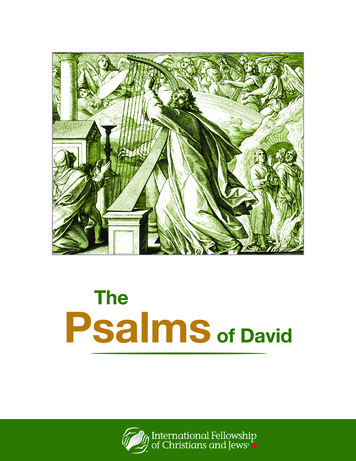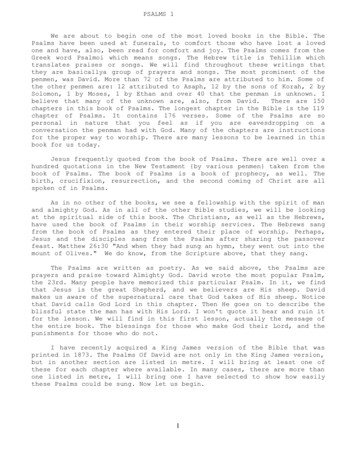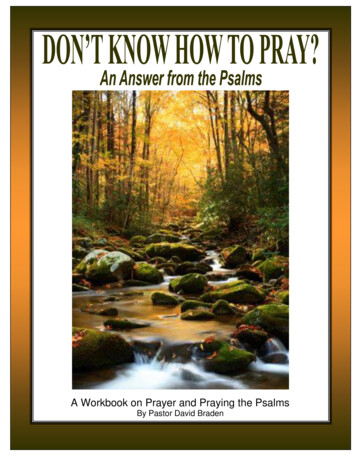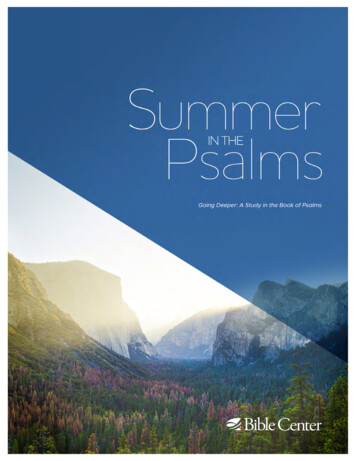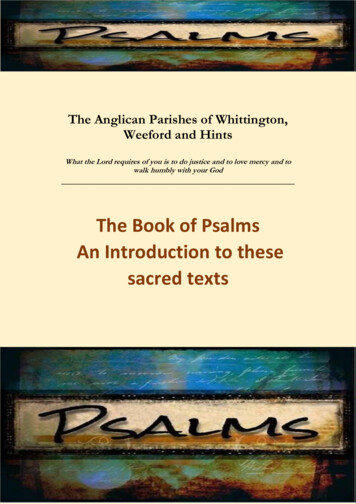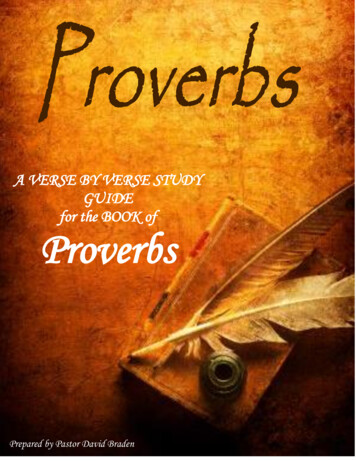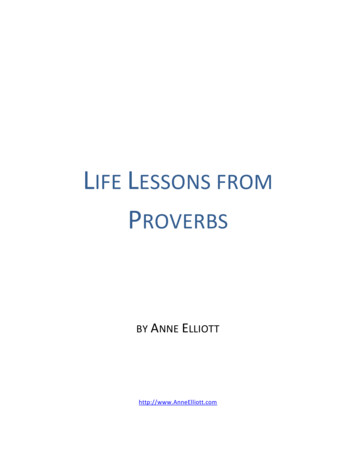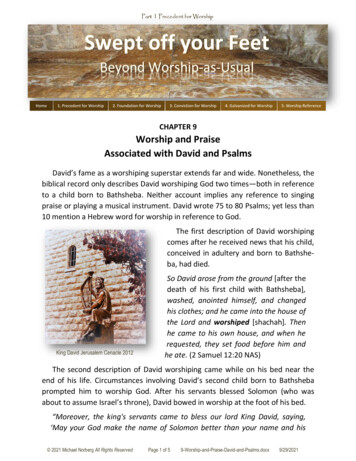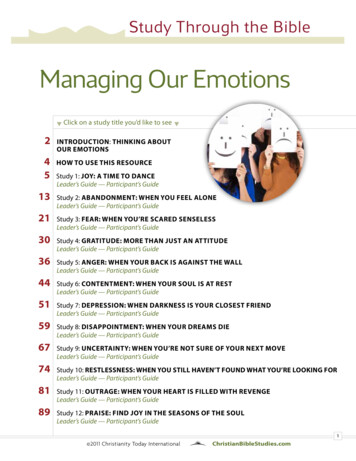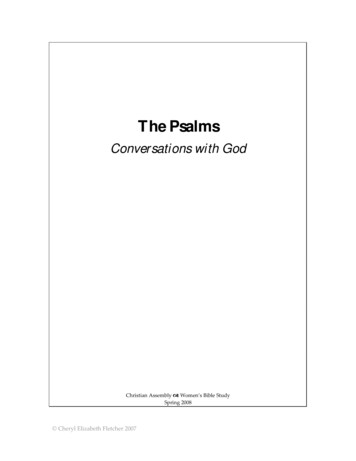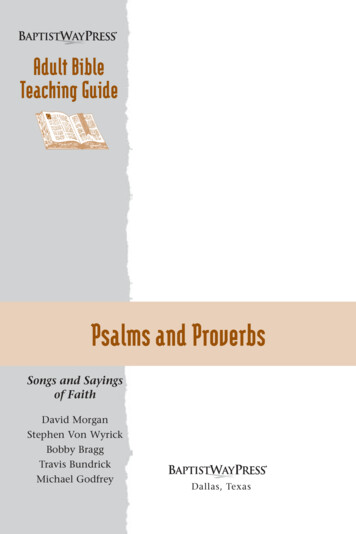
Transcription
Adult BibleTeaching GuidePsalms and ProverbsSongs and Sayingsof FaithDavid MorganStephen Von WyrickBobby BraggTravis BundrickMichael GodfreyDallas, Texas
Psalms and Proverbs—Adult Bible Teaching GuideCopyright 2006 by BAPTISTWAY PRESS .All rights reserved.Printed in the United States of America.No part of this book may be used or reproduced in any manner whatsoeverwithout written permission except in the case of brief quotations. Forinformation, contact BAPTISTWAY PRESS, Baptist General Convention ofTexas, 333 North Washington, Dallas, TX 75246–1798.BAPTISTWAY PRESS is registered in U.S. Patent and Trademark Office.Scripture marked NRSV is taken from the New Revised StandardVersion Bible, copyright 1989, Division of Christian Education ofthe National Council of the Churches of Christ in the United Statesof America. Used by permission. Unless otherwise indicated, allScripture quotations are from the New Revised Standard Version.Scripture marked NIV is taken from The Holy Bible, New International Version(North American Edition), copyright 1973, 1978, 1984 by the InternationalBible Society. Used by permission of Zondervan Publishing House.Scripture marked NASB is taken from the New American StandardBible , Copyright The Lockman Foundation 1960, 1962, 1963,1968, 1971, 1972, 1973, 1975, 1977, 1995. Used by permission.BAPTISTWAY PRESS Management TeamExecutive Director, Baptist General Convention of Texas: Charles WadeDirector, Missions, Evangelism, and Ministry Team: Wayne ShuffieldMinistry Team Leader: Phil MillerEditor & publishing consultant: Ross West, Positive Difference CommunicationsCover and Interior Design and Production: Desktop Miracles, Inc.Printing: Data Reproductions CorporationCover Photo: Mount Hermon (Psalm 42:6), www.istockphoto.comFirst edition: September 2006ISBN 1–931060–81–9
How to Make the Best Use of This Teaching GuideLeading a class in studying the Bible is a sacred trust. This Teaching Guidehas been prepared to help you as you give your best to this importanttask.In each lesson, you will find first “Bible Comments” for teachers, toaid you in your study and preparation. The three sections of “Bible Comments” are “Understanding the Context,” “Interpreting the Scriptures,”and “Focusing on the Meaning.” “Understanding the Context” providesa summary overview of the entire background passage that also sets thepassage in the context of the Bible book being studied. “Interpretingthe Scriptures” provides verse-by-verse comments on the focal passage.“Focusing on the Meaning” offers help with the meaning and applicationof the focal text.The second main part of each lesson is “Teaching Plans.” You’ll findtwo complete teaching plans in this section. The first is called “Teaching Plan—Varied Learning Activities,” and the second is called “TeachingPlan—Lecture and Questions.” Choose the plan that best fits your classand your style of teaching. You may also use and adapt ideas from both.Each plan is intended to be practical, helpful, and immediately useful asyou prepare to teach.The major headings in each teaching plan are intended to help yousequence how you teach so as to follow the flow of how people tend tolearn. The first major heading, “Connect with Life,” provides ideas thatwill help you begin the class session where your class is and draw your classinto the study. The second major heading, “Guide Bible Study,” offers suggestions for helping your class engage the Scriptures actively and developa greater understanding of this portion of the Bible’s message. The thirdmajor heading, “Encourage Application,” is meant to help participantsfocus on how to respond with their lives to this message.As you and your class begin the study, take time to lead them in writing the date on which each lesson will be studied on the first page of eachlesson and/or on the contents page of the Study Guide. You may also findit helpful to make and post a chart that indicates the date on which eachlesson will be studied. If all of your class has e-mail, send them an e-mail3
4PSALMSANDPROVERBS—Teaching Guidewith the dates the lessons will be studied. (At least one church that usesBAPTISTWAY materials for its classes places a sticker on the table ofcontents to identify the dates.)Here are some steps you can take to help you prepare well to teach eachlesson and save time in doing so:1. Start early in the week before your class meets.2. Overview the study in the Study Guide. Look at the table of contents, and see where this lesson fits in the overall study. Then read orreview the study introduction to the book that is being studied.3. Consider carefully the suggested Main Idea, Question to Explore,and Teaching Aim. These can help you discover the main thrust ofthis particular lesson.4. Use your Bible to read and consider prayerfully the Scripture passages for the lesson. Using your Bible in your study and in the classsession can provide a positive model to class members to use theirown Bibles and give more attention to Bible study themselves. (Eachwriter of the Bible comments in both the Teaching Guide and theStudy Guide has chosen a favorite translation. You’re free to use theBible translation you prefer and compare it with the translationschosen, of course.)5. After reading all the Scripture passages in your Bible, then readthe Bible comments in the Study Guide. The Bible comments areintended to be an aid to your study of the Bible. Read also the smallarticles—“sidebars”—in each lesson. They are intended to provideadditional, enrichment information and inspiration and to encourage thought and application. Try to answer for yourself the questionsincluded in each lesson. They’re intended to encourage furtherthought and application, and you can also use them in the classsession itself. Continue your Bible study with the aid of the Biblecomments included in this Teaching Guide.6. Review the “Teaching Plans” in this Teaching Guide. Consider howthese suggestions would help you teach this Bible passage in yourclass to accomplish the teaching aim.7. Consider prayerfully the needs of your class, and think about how toteach so you can help your class learn best.
PSALMSANDPROVERBS—Teaching Guide58. Develop and follow a lesson plan based on the suggestions in thisTeaching Guide, with alterations as needed for your class.9. Enjoy leading your class in discovering the meaning of the Scripturepassages and in applying these passages to their lives.FREE! Additional adult Bible study comments by Dr. Jim Denison,pastor of Park Cities Baptist Church, Dallas, Texas, are online at www.baptistwaypress.org and can be downloaded f ree. These lessons areposted on the internet a week in advance of the first Sunday of use.FREE! Downloadable teaching resource items for use in your classare available at www.baptistwaypress.org! Watch for them in “Teaching Plans” for each lesson. Then go online to www.baptistwaypress.organd click on “Teaching Resource Items” for this study. These items areselected from “Teaching Plans.” They are provided online to make lessonpreparation easier for hand-outs and similar items. Permission is grantedto download these teaching resource items, print them out, copy them asneeded, and use them in your class.ALSO FREE! An additional teaching plan is available each week atwww.baptistwaypress.org.IN ADDITION: Enrichment teaching help is provided in the internetedition of the Baptist Standard. Access the FREE internet informationby checking the Baptist Standard website at www.baptiststandard.com.Call 214–630–4571 to begin your subscription to the printed edition ofthe Baptist Standard.
Writers for This Teaching GuideDavid Morgan wrote “Bible Comments” for lessons 1–6 on Psalms. Dr.Morgan serves as pastor of Trinity Baptist Church, Harker Heights,Texas, and is a veteran Bible study curriculum writer.Stephen Von Wyrick, Ph.D., wrote “Bible Comments” for lessons 7–9 onPsalms and lessons 10–13 on Proverbs. He serves as professor of HebrewBible and Archaeology at the University of Mary Hardin-Baylor and asa lecturer in religion at Baylor University.Bobby Bragg wrote “Teaching Plans” for lessons 1–4 on Psalms. He isassociate pastor of discipleship, Broadmoor Baptist Church, Madison,Mississippi. He has served other churches in Kentucky, Georgia, andTennessee.Travis Bundrick is the writer of “Teaching Plans” for lessons 5–9 onPsalms. He serves as executive pastor, New Hope Baptist Church, CedarPark, Texas. He has served in education and administration ministriesfor churches in Texas, Louisiana, Mississippi, and Tennessee.Michael Godfrey, the writer of “Teaching Plans” on Proverbs, lessons10–13, is the executive director of True Course Ministries, Inc., whichprovides mentoring for ministers and other services related to ministerand church health. He is also an adjunct lecturer in Christian educationat Truett Seminary, Baylor University.6
Psalms and Proverbs: Songs and Sayings of FaithHow to Make the Best Use of This Teaching GuideWriters for This Teaching GuideT H EB O O K36O FP S A L M SSongs of FaithDate of StudyLESSON 1The Way to True HappinessPsalm 1LESSON 2Pleading for God’s HelpPsalms 3; 13; 22:1–5, 22–24LESSON 3Trusting in a Caring GodPsalms 23; 27:1–6LESSON 4Thirsting for GodPsalms 42—43LESSON 5Almost DoubtingPsalm 73LESSON 6The Joy of Worshiping God TogetherPsalm 84LESSON 7To Live a Life That MattersPsalm 90LESSON 8Praise for God’s GoodnessPsalms 100; 103LESSON 9Give Thanks for God’s BlessingsPsalm 116792031425364748494
8PSALMST H EB O O KO FANDPROVERBS—Teaching GuideP R O V E R B SSayings of FaithLESSON 10The Beginning of WisdomProverbs 1:7; 3:1–20LESSON 11Wisdom for Right LivingProverbs 11:1–11, 17–21, 23–25, 28LESSON 12116Wisdom for Every Area of LifeProverbs 22:17–25; 23:10–11, 19–28;24:10–12, 15–20LESSON 13104Wisdom in Human RelationshipsProverbs 25:11–23; 26:18–28How to Order More Bible Study Materials125137147
Focal TextPsalm 1BackgroundLesson OneThe Way to True HappinessPsalm 1Main IdeaFollowing Godfaithfully leads to afull and happy life.Question toExploreWhat kind of life leadsto true happiness?Teaching AimTo lead the class to identifywhat true happiness isand how to experience itP SA L M SSongs of FaithBIBLE COMMENTSUnderstanding the ContextTrue happiness comes from God. Psalm 1 teachesthat this well-being comes from having a rightrelationship with God. A right relationship withGod involves following God’s ways and rejectingthose of the wicked.The Book of Psalms is both a word to God inworship and a word from God. Therefore, placinga psalm that stresses right living at the beginningof the book that was so central to Israel’s worshipseems most appropriate.Many interpreters have recognized that Psalm1 introduces the entire Psalter. Some even thinkPsalm 1 was written specifically as a prologue forthe book. Several aspects of the composition ofPsalm 1 make it a fitting introduction. (1) It isnot numbered in some Hebrew manuscripts, and(2) it is combined with Psalm 2 in others. Also,(3) five significant terms that are found regularlyin Psalms are found in this opening chapter: therighteous, the wicked, sinners, law, and judgment.The Book of Psalms has been divided intofive sections also called books: Book I (Psalms1—41); Book II (Ps. 42—72); Book III (Ps.73—89); Book IV (Ps. 90—106); and Book V9
10PSALMS: Songs of Faith—Teaching Guide(Ps. 107—150). A doxology concludes each of these books, with Psalm150 functioning as a final doxology for the entire book.Early Jewish writings suggested a parallel between these five booksand the five books of the Torah, the Law (Genesis, Exodus, Leviticus,Numbers, Deuteronomy). One reason given for this arrangement was thatthe final editor of Psalms wanted the readers to view the Psalms as wellas the Torah as God’s law. The flow of the five books may also parallelIsrael’s history: God made a covenant with David, and failure to keepthe covenant obligations resulted in Jerusalem’s destruction and exile ofthe people (Books I–III). Books IV and V pick up from that point andproclaim God’s reign.Psalm 1 is one of nine wisdom psalms (1, 37, 49, 73, 112, 119, 127, 128,133). These psalms focus more on teaching than worship. They demonstrate the importance of receiving instruction that forms character, informsbehavior, and ultimately determines one’s destiny.The psalm contrasts the way of the righteous to that of the wicked. Thiscontrast occurs frequently in Scripture. Scripture elsewhere uses imagesof life and death to describe this distinction (Deuteronomy 30:19; Jeremiah 21:8). In Proverbs, the wise person who seeks life appreciates God’sinstruction, while the fool despises it (Proverbs 1:7). The way of the godlyis one of “blessings” and the way of the wicked of “curses” in Deuteronomy30:19. Also, Jeremiah 17:5–8 shows similarities to Psalm 1.Psalm 1 opens with a statement of its theme and then develops it bycontrasting godly and ungodly living. The psalm contrasts the happinessof the righteous (Psalm 1:1–3) to the ultimate futility of the wicked life(Ps. 1:4–6).Interpreting the ScripturesThe Godly Life (1:1–3)1:1. Those who are “happy” (“blessed,” NASB, NIV) reject the way of thewicked and delight in God’s law. No English term expresses fully themeaning of the Hebrew word for “happy.” The word suggests that a person’s happiness is more God’s gift and a blessing God bestows. Using theterm in this way as a beatitude celebrates the character and behavior of therighteous. The best interpretation of the phrase may be, how rewarding isthe life of.P SALMS : Songs of Faith
PSALMS: Songs of Faith—Teaching Guide11Some understanding of Hebrew poetry will help us interpret the entireBook of Psalms. Hebrew poetry is based on the relationship of the content between lines and not cadence or sound. Parallelism of content is animportant feature of Hebrew poetry.The most common types of parallelism are synonymous, synthetic, andantithetical. In synonymous parallelism, the two lines use different languageto convey the same idea (see Ps. 6:2). Synthetic poetry is observed when thesecond line completes the thought of the first (see 23:6). Poetry with linesthat have opposite meanings is called antithetical (see 1:6).Three parallel phrases in verse 1 point out that those who are happyreject the path of sinners. The parallelism that describes the godly manrejecting the counsel and example of the wicked is most likely synonymous. The lines are three ways of asserting that godly people spurn wickedways. Some interpreters consider the verse an example of step (synthetic)poetry. They see a downward spiral from “walking” to “standing” to “sitting.” Furthermore, in this understanding the words “wicked,” “sinners,”and “scoffers” depict a decline. Choosing between the two kinds of parallelism is only a matter of emphasis.Godly people reject the advice of the wicked. The designation “wicked”usually refers to God’s enemies and thus foes of God’s people. Godlypeople do not “take” (“stand in,” NASB, NIV) the path of sinners. “Sinners,”a more specific term than “wicked,” means those who miss the mark orchoose the wrong way.The godly do not “sit in the seat of scoffers.” “Scoffers,” the strongestof the three words, means those who arrogantly refuse to accept instruction(see Proverbs 1:22). They consider themselves above the need to listen tothe guidance of God and of others. The “seat” of the scoffers implies morethan a place of sitting. It signifies a session or assembly. The importance ofthis distinction will become clear in later verses.“Walk,” “stand,” and “sit” show complete action and here indicate ahabitual activity. The righteous reject the godless way of life as one thatis unstable.1:2. Scoffers ridicule the Lord’s instruction, but the righteous delightin God’s law. Delighting in God’s law may sound odd to those whoequate law with rules and regulations. Understanding law in this waymisses the focus of this passage, for the Hebrew word for “law,” torah,has a much broader meaning than a list of dos and don’ts. The termoften referred to the first five books of the Bible. While these booksL ESSON 1: The Way to True Happiness
12PSALMS: Songs of Faith—Teaching Guidecontain many commandments, they also narrate stories that helped tomold the character and conduct of the Israelites.God’s “law” is basically the instruction, teaching, or guidance that helps usto establish and maintain a harmonious relationship with God. Law presupposes God’s grace and provides the framework for living within God’scovenant relationship. God’s first word at Mount Sinai reminded thepeople of the Lord’s gracious deliverance. Only after the people gratefullycommitted themselves to serve God did they receive the Ten Commandments (Exodus 19:1–8; 20:1–17).Godly people are open to God’s direction. Preoccupation or concern maycapture the idea of “delight.” The word for “meditate” denotes more thansilent reflection. The word can be used for a low murmuring of repetition.“Day and night” suggests habitual, perhaps even continual, activity.Two grammatical features in verse 2 heighten the contrast between thewicked and the godly. The psalm opens with a strong word of contrast,“but.” Also, the grammar suggests that delighting and meditating in thelaw were habitual.1:3. The writer illustrated the solid foundation of righteous people bycomparing them to “trees planted by streams of water” (see also Jeremiah17:5–8). The term “planted”—literally, transplanted—may imply that thegodly person’s happiness is due to God’s grace and activity.The deep roots and stability of the righteous contrast with the motionand movement of the wicked (1:1). Trees draw nutrients from the groundand transform them into leaves and fruit. Meditating on God’s law servesa greater purpose than simply knowing facts and information about God.The purpose of God’s instruction is to transform people into Christlikeindividuals.The life of the godly is like a tree whose leaf does not “wither.” It is vitaland full of life.Getting trees established in my backyard in central Texas has proveddifficult. I’m trying now for the third time. Soon after I moved into myhouse nine years ago, the two trees that came with it died. Two years later,I had a nursery plant a red oak and a silver maple. They fared well thefirst year. Then, central Texas experienced an unseasonably hot and drysummer, which scorched them. The trees dropped leaves, and the leavesthat remained wilted. I held out hope that they might live, but both failedto come back the next spring.P SALMS : Songs of Faith
PSALMS: Songs of Faith—Teaching Guide13The Instability of the Wicked (1:4–6)1:4. The wicked are as fleeting as the righteous are firmly rooted. Thetranslation “the wicked are not so” misses the intensity and abruptnessof the Hebrew, which literally reads, “not so the wicked.” They are “likechaff,” without substance. Heaviness was associated with significanceand importance. To illustrate, a basic meaning of the word glory is weightor mass.The wicked “are like chaff that the wind drives away.” The psalmistdrew on a common image to illustrate. Crops were gathered to a localthreshing floor during harvest. There they were beaten to loosen the grainfrom the waste and then tossed into the air. The wind blew away the strawand chaff. The heavier grain fell to the floor, where it was gathered.We can still see this imagery in harvests. One of my fondest childhood memories is of sitting in my grandpa’s pickup while he and Daddyharvested wheat. Sometimes they let me ride on the combine. I remember watching golden kernels fall into the hopper. Looking back over thehopper allowed me to see the straw and other chaff being tossed back intothe fields. What was taken to town to sell was the “heavy” grain.Two other details emphasize the contrast between “tree” and “chaff.” (1)The writer employs a pun, because the Hebrew words for “tree” and “chaff ”each have two letters, and they end with the same letter. (2) Also, note thatthe poet wrote three lines about the tree but only one about chaff. Eventhe number of words expresses more heaviness and significance for treesand thus for the righteous.1:5–6. Because the wicked are “light,” they have no contribution to makein society. God will honor the righteous, but the “wicked will perish.”The synonymous parallelism in verse 5 suggests that “judgment” doesnot refer to final judgment here. The psalmist was contrasting how lifestyles affected one’s standing in the community. The word “stand” differsfrom the one translated “stand” in verse 1, but both denote that the wickedhave no foundation in this life.“Judgment” and “congregation” (“assembly,” NASB, NIV) parallel eachother. The background for understanding this verse comes from the process used in biblical times to make decisions. Community leaders andelders gathered at city gates to attend to the affairs of the community (seeRuth 4:1–12). “Righteous” probably refers to the worshiping community.What the psalm seems to be saying is that when the community gatheredto determine justice, the wicked would have no place or influence.L ESSON 1: The Way to True Happiness
14PSALMS: Songs of Faith—Teaching GuideThe psalmist brought the “righteous” and the “wicked” together in thesame verse for a final contrast. God “watches over the way of the righteous.” The word “watches” (literally, knows) suggests personal relationshipand not intellectual knowledge. The term is used elsewhere for sexual intimacy between husband and wife (Genesis 4:1, 25; 1 Samuel 1:19). Therighteous person is connected to God in a way similar to the intimacybetween spouses.The wicked person, though, will “perish.” The life of the wicked followsa road or course that comes to nothing or to ruin, like a dead end. Thelife of the wicked in itself becomes its own inevitable punishment. To bewicked is to be centered on self and not on God. To replace God with selfis the essence of sin. The righteous may commit acts that displease God,but they are righteous because they are open to God’s instruction.Focusing on the MeaningTrust God. Happiness comes from being connected to and dependent onGod. To be dependent on God implies that you trust God. Adam and Evechose to eat of the forbidden fruit because they felt that God might havebeen hiding something from them. The serpent raised this doubt in theirminds: “For God knows that . . . you will be like God” (Genesis 3:5).Prepare to receive God’s word. Delighting in and meditating on God’sword transforms individuals into godly people. Christians are both savedand transformed by God’s grace. God’s transformation is most effectivewhen we place ourselves in a godly environment through regular reflectionon God’s word.A young woman in my church once asked me what things Christianscannot do. We miss a great deal of the blessedness of our relationship withGod if we think of it only as a list of prohibitions. Consider God’s instructions to us as God’s way of providing stability and direction in an unstableand misled world.Appreciate godly living. The conclusion that godly people prosper in allthings clearly arises from one’s faith and not from superficial appearances.Many of the psalms (some of which we will examine) describe the frustration of the righteous who felt that the wicked prospered more than theydid. Those who heed God’s instruction become the kind of people Godcreated them to be. Prosperity should also be considered a result of godlyP SALMS : Songs of Faith
PSALMS: Songs of Faith—Teaching Guide15living and not as its reward. This kind of prosperity far surpasses that ofmaterial success.Never give up. If you’re concerned that you’ve tried and failed, again andagain, consider this. The trees I planted are now flourishing.TEACHING PLANSTeaching Plan—Varied Learning ActivitiesConnect with Life1. Prior to class, find some pictures of people who appear to be happy.Invite the class to give opinions as to why they think the people inthe pictures appear to be happy. They might look at the setting ofthe pictures or the other people who appear in the pictures. Ask participants whether they know people who appear to be happy on theoutside but are unhappy on the inside.2. Provide a slip of paper for each member of the class. Ask the peoplein the class to write on the paper their ideas of “true happiness”(“True happiness is . . . .” A copy can be downloaded from www.baptistwaypress.org.). In order to help participants formulate theiropinions, share your definition of what happiness is. Tell them tohold the slips of paper until near the end of the teaching session.Guide Bible Study3. Share with the class the background information about the Book ofPsalms from “Introducing Psalms: Songs of Faith” in the Study Guideand “Understanding the Context” in this lesson in this TeachingGuide. Then introduce Psalm 1 using information in “Understanding the Context” in this Teaching Guide and “Take Care!” in the StudyGuide.4. Divide the class into three groups. (Have six or fewer people in agroup. Form additional groups with duplicate assignments if morethan eighteen are present.) Assign each group one of the following three words: “wicked”; “sinners”; “mockers” (NIV). Give theL ESSON 1: The Way to True Happiness
16PSALMS: Songs of Faith—Teaching Guidefollowing instructions to each group: (a) Study how the assignedword is used in Psalm 1:1. (b) Develop an explanation of the meaning of the word by using the information in the Study Guide andalso using different Bible translations. (c) Identify contemporaryexamples and illustrations of the assigned word. The goal is forthe members to give examples of places and activities people needto stay away from in order to live a life described in this psalm. (Acopy of this assignment is available at www.baptistwaypress.org.)5. Invite the groups to report. Then direct participants to the information in the last paragraph under “Take Care!” in the Study Guide,which points out, “Ungodly counsel often arrives in stealth mode.”Discuss ways ungodly counsel can slip into our lives. You may wantto suggest an example of someone who followed ungodly counsel.6. Before class, prepare several road signs that represent laws. Use a stopsign and a speed limit sign. Ask the class whether they delight inthese laws. You will probably hear some different reactions. Remindthe class that the laws are there for their safety. Too, God’s laws are inthe Bible to guide us through life. Invite comments about the meaning of God’s law from the information in the Study Guide under“Focus On God’s Way.” Invite members to share a law God has giventhat has guided them.7. Give the members of the class a bottle of water with a tag around theneck of the bottle. You can attach the tag by using a rubber band andan index card. Take a hole punch, make a hole in the card, and thenuse the rubber band to attach the card to the water bottle. Instructparticipants to write on their cards the ways God’s word replenishesand adds nourishment to their lives. Encourage them to put thisbottle of water in a place they will see often to remind them of theways God replenishes us in life.8. Refer the class to the section “The Presence of God” in the StudyGuide. Summarize the section. Divide the members into small groupsof six or fewer participants so they can discuss questions 1, 3, and 4in the Study Guide and report to the entire group.P SALMS : Songs of Faith
PSALMS: Songs of Faith—Teaching Guide17Encourage Application9. Lead the members to take the slips you gave to them at the beginning of class and look at what they wrote about “true happiness.”Encourage them to reflect on the lesson and then to tell whethertheir ideas of “true happiness” have changed. Give participants anopportunity to share how their definitions might have changed andhow it will affect their life. Invite comments that summarize whatPsalm 1 says about true happiness is and how to experience it.10. Instruct the class to look at the section “What Actions Might WeTake?” in the Study Guide. Challenge the members to take time thenext week to do one or more of the ideas in this section.11. Close the class with a prayer for the members. Pray that God willlead them in the path of wisdom and allow them to delight inGod’s word.Teaching Plan—Lecture and QuestionsConnect with Life1. Start the class by using the activity the Study Guide writer gives about“Blessed is the person who. . . .” Give the class a few minutes to thinkabout the statement, and then ask for responses. Allow serious aswell as lighthearted answers to the statement. Guide the discussionto show that there are broad and varied interpretations of what being“blessed” is in a person’s life.2. Invite participants to comment on the meaning and truth of thisstatement: Being blessed is not a specific event in life; rather it is a way oflife. Then direct them to Psalm 1. Invite someone to read the passagealoud while the class listens for what the psalm teaches about truehappiness.Guide Bible Study3. Share with the class the background information about the Bookof Psalms from “Introducing Psalms: Songs of Faith” in the StudyGuide and “Understanding the Context” in this lesson in thisL ESSON 1: The Way to True Happiness
18PSALMS: Songs of Faith—Teaching GuideTeaching Guide. Then use the material under the section “TakeCare!” in the Study Guide to focus the lesson on Psalm 1. As youpresent the material, emphasize the theme “Take Care!”4. Refer to Psalm 1:1, and guide the class to understand the meaningof the words “wicked,” “sinners,” and “mockers” (NIV), using information in this Teaching Guide and in the Study Guide. Ask participantsto think about expressions that might be used today to describe thesewords. You may want to bring a different translation of the Biblethat uses different words or invite class participants to read fromthe various translations they have. Guide the members to discovercontemporary thoughts about th
David Morgan wrote “Bible Comments” for lessons 1–6 on Psalms. Dr. Morgan serves as pastor of Trinity Baptist Church, Harker Heights, Texas, and is a veteran Bible study curriculum writer. Stephen Von Wyrick, Ph.D., wrote “Bible Comments” for lessons 7–9 on Psalms and le
